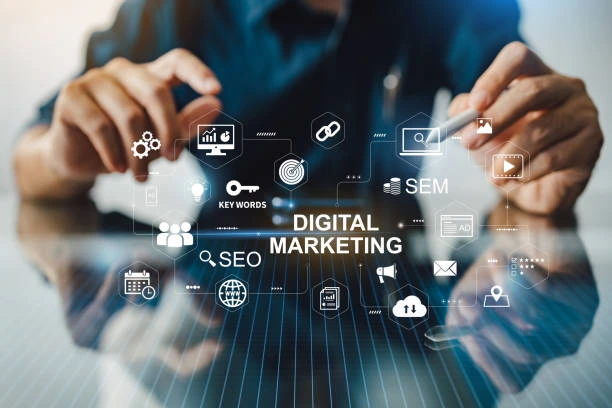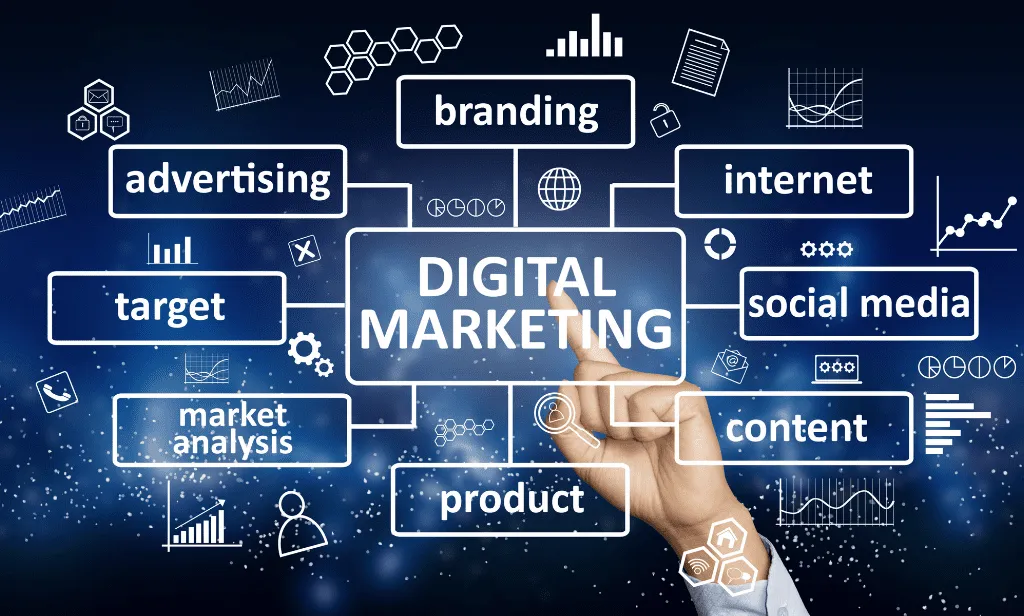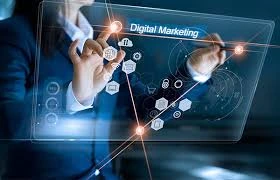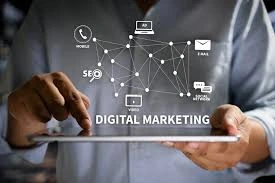In today’s fast-paced digital world, businesses must establish a strong online presence to stay competitive. Digital marketing has become the backbone of modern marketing strategies, helping brands connect with their target audience, increase visibility, and drive sales.
Digital marketing encompasses various online strategies and techniques used to promote products, services, and brands. It includes search engine optimization (SEO), content marketing, social media marketing, email marketing, pay-per-click (PPC) advertising, and more. Unlike traditional marketing, digital marketing leverages the power of the internet, data analytics, and automation to create personalized and highly targeted campaigns.
This guide will provide a comprehensive overview of digital marketing, exploring its key components, benefits, strategies, and the latest trends to help businesses succeed in the digital landscape. Whether you’re a beginner or looking to refine your marketing approach, this guide will equip you with essential knowledge to navigate the ever-evolving world of digital marketing.

Table of Contents
Key Components of Digital Marketing
Digital marketing is a broad field that includes various strategies and channels to promote businesses online. Here are the key components of digital marketing:
1. Search Engine Optimization (SEO)
- Improves website visibility on search engines (Google, Bing, etc.).
- Includes on-page SEO (keywords, content, meta tags) and off-page SEO (backlinks, domain authority).
- Technical SEO (site speed, mobile optimization, structured data).
2. Content Marketing
- Creating and distributing valuable, relevant content to attract an audience.
- Includes blogs, videos, infographics, ebooks, and case studies.
- Supports SEO, social media, and lead generation.
3. Social Media Marketing (SMM)
- Promotes brands on platforms like Facebook, Instagram, Twitter, LinkedIn, and TikTok.
- Involves organic and paid strategies to increase engagement and brand awareness.
- Uses influencer marketing and community building.
4. Pay-Per-Click Advertising (PPC)
- Paid ads on search engines (Google Ads, Bing Ads) and social media.
- Includes display ads, retargeting, and shopping ads.
- Works on a bidding system where advertisers pay per click.
5. Email Marketing
- Sending personalized messages to nurture leads and retain customers.
- Includes newsletters, promotional offers, and automated drip campaigns.
- High ROI when done correctly.
6. Affiliate Marketing
- Partnering with affiliates (bloggers, influencers) who promote products/services for a commission.
- Performance-based marketing model.
- Involves tracking affiliate links and commissions.
7. Influencer Marketing
- Collaborating with influencers to promote products/services.
- Leverages the influencer’s credibility and audience reach.
- Effective on social media platforms.
8. Mobile Marketing
- Targeting users on smartphones and tablets.
- Includes SMS marketing, app-based marketing, and location-based services.
- Uses push notifications and mobile-friendly websites.
9. Video Marketing
- Engaging audiences through videos on YouTube, TikTok, Instagram Reels, etc.
- Includes live streaming, explainer videos, testimonials, and ads.
- Boosts engagement and conversion rates.
10. Conversion Rate Optimization (CRO)
- Enhancing website design and content to increase conversions.
- Uses A/B testing, heatmaps, and user experience improvements.
- Focuses on landing pages, calls-to-action, and checkout processes.
Digital marketing is essential in today’s world because it allows businesses to reach a global audience, engage with customers in real time, and measure results more effectively than traditional marketing. Here’s why it matters:

Challenges of Digital Marketing
1. High Competition
The online marketplace is highly competitive, making it crucial for businesses to differentiate themselves.
2. Algorithm Changes
Search engine and social media algorithm updates can impact visibility and engagement.
3. Cybersecurity Threats
Businesses must prioritize data protection and cybersecurity to maintain customer trust.
4. Constant Adaptation
Digital marketing trends and technologies evolve rapidly, requiring businesses to stay updated.

Why Digital Marketing Matters in Today’s World
1. Wider Reach & Targeted Audience
With billions of people online, digital marketing provides access to a global audience. Unlike traditional marketing, it allows businesses to target specific demographics based on age, location, interests, and behavior.
2. Cost-Effective & High ROI
Compared to traditional advertising (TV, print, radio), digital marketing offers a more affordable way to promote products and services. Strategies like SEO, content marketing, and social media advertising provide better ROI, making it accessible for both startups and large enterprises.
3. Measurable & Data-Driven
With tools like Google Analytics, Facebook Ads Manager, and email marketing platforms, businesses can track performance in real time, analyze customer behavior, and make data-driven decisions to improve their strategies.
4. Better Customer Engagement
Digital marketing allows businesses to interact directly with customers through social media, email, chatbots, and personalized content. This enhances brand loyalty and builds strong relationships with consumers.
5. Increased Conversion Rates
Through strategies like email marketing, PPC (pay-per-click), and retargeting, businesses can turn leads into customers more efficiently. Personalized and optimized content helps improve conversion rates.
6. Mobile & Social Media Influence
With the rise of smartphones, consumers spend a significant amount of time on social media platforms. Digital marketing ensures businesses are visible where their customers are most active.

Advantages of Digital Marketing
1. Cost-Effectiveness
Digital marketing provides a cost-effective alternative to traditional marketing methods, allowing businesses to reach larger audiences at lower costs.
2. Measurable Results
With tools like Google Analytics and social media insights, businesses can track performance and optimize strategies accordingly.
3. Wider Audience Reach
The internet enables businesses to reach a global audience without geographical limitations.
4. Targeted Marketing
Digital marketing allows precise targeting based on demographics, interests, and behaviors.
5. Improved Customer Engagement
Social media and personalized content help businesses interact directly with customers and foster brand loyalty.

How to Create an Effective Digital Marketing Strategy
Creating an effective digital marketing strategy involves a structured approach to reaching your target audience, increasing brand awareness, and driving conversions. Here’s a step-by-step guide:
1. Define Your Goals and Objectives
- Identify what you want to achieve (e.g., brand awareness, lead generation, sales growth).
- Set SMART goals (Specific, Measurable, Achievable, Relevant, Time-bound).
2. Understand Your Target Audience
- Create buyer personas based on demographics, interests, pain points, and online behavior.
- Use analytics tools (Google Analytics, social media insights) to gather audience data.
3. Analyze Competitors
- Identify key competitors and analyze their digital marketing strategies.
- Assess their strengths and weaknesses to find opportunities.
4. Choose the Right Digital Channels
- SEO (Search Engine Optimization) – Improve website ranking on search engines.
- Content Marketing – Create blogs, videos, infographics, and other valuable content.
- Social Media Marketing – Use platforms like Facebook, Instagram, LinkedIn, and Twitter.
- Email Marketing – Engage with prospects through personalized email campaigns.
- Pay-Per-Click (PPC) Advertising – Run targeted Google Ads, social media ads.
- Influencer Marketing – Partner with influencers to reach a wider audience.
5. Develop a Content Strategy
- Plan a content calendar with high-quality, engaging, and shareable content.
- Optimize content for SEO and user intent.
- Use different content formats (videos, blogs, podcasts, eBooks).
6. Implement Marketing Automation & Tools
- Use tools like HubSpot, Mailchimp, or Hootsuite for automation.
- Leverage CRM (Customer Relationship Management) software to manage leads.
7. Set a Budget
- Allocate resources effectively across different marketing channels.
- Monitor ROI (Return on Investment) and adjust spending accordingly.
8. Monitor Performance & Optimize
- Track key performance indicators (KPIs) like traffic, conversions, and engagement.
- Use tools like Google Analytics, SEMrush, or Facebook Insights.
- Continuously test and optimize campaigns (A/B testing, retargeting).

Top Tools for Digital Marketing Success
1. Google Analytics
- Purpose: Tracks and reports website traffic, user behavior, and other valuable metrics.
- Why Use It: Provides insights into audience demographics, behavior, and conversions.
2. HubSpot
- Purpose: All-in-one inbound marketing, sales, and CRM platform.
- Why Use It: Offers tools for email marketing, content management, social media marketing, and more.
3. Hootsuite
- Purpose: Social media management platform.
- Why Use It: Allows you to schedule posts, track social media engagement, and analyze performance across various platforms.
4. Mailchimp
- Purpose: Email marketing automation tool.
- Why Use It: Easy-to-use tool for creating and sending newsletters, managing email lists, and analyzing email campaign performance.
5. SEMrush
- Purpose: SEO, SEM, and content marketing tool.
- Why Use It: Provides keyword research, competitive analysis, backlink tracking, and more to improve SEO performance.
6. Canva
- Purpose: Graphic design tool for creating marketing materials.
- Why Use It: Simplifies creating social media posts, presentations, ads, and other visual content, even for beginners.
7. Google Ads
- Purpose: Paid search engine marketing.
- Why Use It: Targets users through paid search results, display ads, and remarketing, offering a powerful ROI when used strategically.
8. BuzzSumo
- Purpose: Content research and social listening tool.
- Why Use It: Helps identify trending topics, content ideas, and influencers in your niche.
9. Ahrefs
- Purpose: SEO and backlink analysis tool.
- Why Use It: Provides in-depth site audit, keyword research, and backlink analysis features, essential for SEO optimization.
10. Trello/Asana
- Purpose: Project management tools.
- Why Use It: Keeps digital marketing campaigns organized with task management and collaboration features for teams.
11. Moz
- Purpose: SEO toolset.
- Why Use It: Offers keyword research, link building, site audits, and rank tracking features to boost organic search traffic.
12. Sprout Social
- Purpose: Social media management tool.
- Why Use It: Combines scheduling, engagement, analytics, and social listening to improve social media strategy.
13. Yoast SEO
- Purpose: SEO plugin for WordPress.
- Why Use It: Helps optimize content for search engines, improving visibility and rankings.
14. Google Tag Manager
- Purpose: Tag management system.
- Why Use It: Allows you to update measurement codes and marketing tags without needing code changes, enhancing website tracking.
In conclusion, digital marketing has revolutionized the way businesses interact with consumers, providing innovative tools and strategies to reach broader, more targeted audiences. Its ability to offer measurable results, personalization, and the integration of new technologies such as AI and data analytics ensures its continued relevance and importance in today’s fast-paced business environment. As consumer behaviors evolve and new platforms emerge, digital marketing will remain an essential component for businesses to thrive, adapt, and stay competitive in an increasingly digital world. Businesses must embrace these changes, stay agile, and continuously refine their strategies to maximize their potential.
